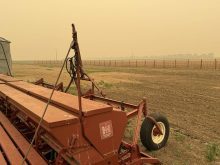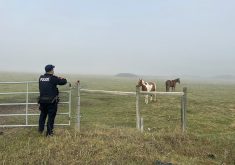Alta. and B.C. ranchers say communication also important as they talk about lessons learned this dry, dangerous summer
Planning, community support and being able to move quickly have been integral for ranchers managing grazing cattle as wildfires advance.
The Hoffman-Turner family is keeping an eye on the Ross Moore Lake Fire, near Kamloops, B.C., after it forced them to evacuate their home more than five weeks ago.
Diane and Grant Hoffman, their daughter Kari Lynn and her partner Cody Turner and sons. run a cow-calf, sheep and direct-market beef operation.
Strong community support helped them save their homes and structures.
The Hoffman-Turner family is like many in British Columbia and Alberta this summer where wildfires have made managing cattle herds unpredictable and stressful.
Horses, sheep and show heifers belonging to their sons were moved off the property first. Then cattle closest to treelines were moved to open fields. After helping neighbours move cattle, they packed their valuables into vehicles. They also moved their custom-order meat stores to a safe location and postponed deliveries.
Eventually, most of the cow herd was moved to the local B.C. Livestock Co-op sale yard.
“So yes, you can have a plan,” says Kari Lynn Hoffman, “such as who to call to help you with cattle and horses. But everything depends on the fire’s exact location and conditions.
“We worked closely with our Regional District of Thompson-Nicola, keeping them informed of each cattle move,” says Hoffman. “And we had a really good rancher liaison.”
That liaison, appointed by the B.C. Cattlemen’s Association, works with B.C. Wildfire Services and helped the Hoffmans to secure the necessary permits to move people in and out of evacuation order zones.
She says a person who set up a Facebook community fire page was pivotal in the Knutsford area, keeping rural residents informed of developments. This woman helped get essential information to those who needed it, she says.
“She was our life source,” says Hoffman, who adds that this liaison was also responsible for fast aerial support when fire hot spots were reported. Another community group provided affected families with meals.
“Communication between family members is also important,” says Hoffman, noting that the person who makes the fire plans is not necessarily the one to take charge and make quick decisions on the ground. Every family member has their strength, which must be recognized when mobilizing plans and resources.
Priorities involved making fire breaks around buildings and dismantling wooden fence rails between trees and buildings. They learned the importance of building “truck-width” fire breaks between trees and fencelines and even between fencelines and grass on open pastures.
The Hoffmans lost 800 acres of grassland slated for fall grazing in the fire. Selective harvesting of trees over the years served as good fire protection.
“Don’t stack your bales in a dry year,” says Hoffman, adding that the stacked hay is what they lost, the result of live embers.
The Hoffmans plan to cull the herd hard, find local fall pastures and hay sources, arrange for helicopter seeding and take advantage of insurance coverage for about 11 kilometres of fencing. They intend to be salvage logging during winter.
Rest is also important, although it can be challenging when fires are moving. Fire situations can drive people to keep going, 24 hours a day, says Hoffman.
“You make better decisions and use better judgment when you are rested, so try to get some sleep when the fire is quiet.”
At first, for the Hoffmans the time for rest was from 2 a.m. to 5 a.m., but the time gradually extended as days passed.
Clint Lambert, who runs a cow-calf herd with his wife, Deanna, near Burns Lake in north-central B.C., says citizen involvement is critical to fire control in northern B.C.
“Get organized,” he says.
Communication and resource management proved inefficient during the 2018 fires in their region, which were largely controlled by local ranchers and logging contractors.
After that, Lambert joined the regional district board as a director to initiate change.
Citizens, rather than police, now control traffic at important junctions and the Chinook Emergency Response Society was formed. This group has taken action at 27 fires this year. Members have 12 pieces of heavy equipment between them that are used to clear out trees and make fire guards. They are later compensated for their resources by B.C. Wildfire Services.
The Chinook group formed pods of people in the community who are mostly volunteers. Each pod has a leader who covers communications in their area.
“At any given fire, 30 to 60 people show up,” says Lambert.
They can reach the fire quicker than B.C. Wildfire Service, according to Lambert.
The group also organizes fire awareness courses every spring.
Aaron Ford and his wife, Lori, operate a cow-calf and backgrounding operation in the southeast area of Alberta’s Peace River region.
“Without a (fire) plan, you second guess yourself the whole time,” he says.
Firefighters have recently left from fighting the Peavine Fire, which started on May 5 and has burned all summer. Some of their neighbours lost homes, corrals, other structures and feed supplies in the fire.
Ford points out that fires can move much quicker than expected and that resources in most rural fire departments are not sufficient, so a strategic fire plan is imperative.
His calving cow herd had to be moved twice. To protect his equipment, he moved it to a cultivated field.
He learned the value of an old sprayer, which he used to water down hay stacks. He eventually secured water trucks to water the hay and his yard.
Ford’s suggestions for a fire plan are included in the list below. He had previously cleared a strip around a leased pasture, which he believes saved his fences from burning.
Also in Alberta’s Peace River region, Richard and Maureen Brochu, who run a cow-calf and backgrounding operation, didn’t have a plan. When they got word of what developed into the Sturgeon complex fire, they didn’t panic but sat down and made plans.
A 100-acre field from which oats were harvested last year was disced up to eliminate a stubble fire and all their management groups, including calving females, were moved to that field. So was all their equipment, which they fenced off from the cattle with temporary electric fencing.
In the end, they lost some outbuildings and about 20 km of fencing.
Richard Brochu stayed home through the evacuation order to water yards, bales and to fight fires that flanked their property on three sides.
The B.C. Cattlemen’s Association says Agri-Recovery programs will likely be there to help producers with hay losses caused by the fires, but announcements will not be confirmed until early September, according to Kevin Boon, general manager of the BCCA.
For the Access-to-Hay program, email hay@cattlemen.bc.ca or phone 250- 241-5640. There is also a resource portal for Alberta producers, at Farming the Web at https://farmingtheweb.ca.
How to make a fire plan
- Get a fire risk evaluation on private and commercial properties by FireSmart in British Columbia or local fire department.
- Create a list of community contacts, including your rancher liaison through the cattle association, regional district authorities, fire department, Provincial Wildfire Services and neighbours.
- Gather your ranch information, including names, addresses, phone numbers and property identification numbers and range information, to give to officials.
- Consider forming a community emergency response team and taking stock of potential equipment available and who can serve as communication liaison.
- Where can fire breaks be built into property plans and what should be focus areas?
- Practise selective logging on private land to reduce fuel loads and clean up slash piles. This also increases grazing opportunities.
- Take fire suppression training (S-100 level).
- Keep selective firefighting gear ready.
- Ensure all ranch vehicles are equipped with fire extinguishers and a shovel.
- Review insurance protection for fencing, equipment and feed supplies.
- Keep old portable sprayers.
- Keep grass mowed in yards.
- Clean up debris around buildings.
- Determine where livestock and equipment can be moved to and how that can be executed.
- Make a list of valuables that should be packed up in case of evacuation.
- Ensure you take some rest.
















